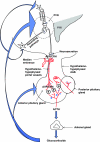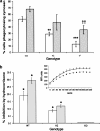Glucocorticoids: exemplars of multi-tasking
- PMID: 16402112
- PMCID: PMC1760726
- DOI: 10.1038/sj.bjp.0706456
Glucocorticoids: exemplars of multi-tasking
Abstract
Well over 80 years ago Philip Smith described the beneficial clinical effects of adrenocortical extracts in animal models of adrenal insufficiency. In the ensuing years, scientists across the globe have sought to understand the mechanisms by which adrenal hormones and their synthetic analogues produce their complex and varied actions. Particular attention has focused on the glucocorticoids, partly because they have a vital place in the treatment of inflammatory and autoimmune disorders but also because dysregulation of the secretion and/or activity of endogenous glucocorticoids is increasingly implicated in a number of common disorders that pose a growing clinical burden, such as obesity, type II diabetes, the metabolic syndrome, hypertension and depression. This review considers some of the key advances that have been made in our understanding of the physiology, pathology and pharmacology of the glucocorticoids. Emphasis is placed on the molecular mechanisms of glucocorticoid signalling and the complex mechanisms that regulate the access of steroids in the systemic circulation to their receptors in their various target cells and tissues. In addition, consideration is given to the irreversible 'organisational' actions of glucocorticoids in perinatal life and to the potential role of the steroids in the aetiology of disease.
Figures





References
-
- BARNES P.J., ADCOCK I.M. How do corticosteroids work in asthma. Ann. Intern. Med. 2003;139:359–370. - PubMed
-
- BEATO M., HERRLICH P., SCHUTZ G. Steroid hormone receptors: many actors in search of a plot. Cell. 1995;83:851–857. - PubMed
-
- BENESOVA O., PAVLIK A. Perinatal treatment with glucocorticoids and the risk of maldevelopment of the brain. Neuropharmacology. 1989;28:89–97. - PubMed
-
- BROWN R.W., DIAZ R., ROBSON A.C., KOTELEVTSEV Y.V., MULLINS J.J., KAUFMAN M.H., SECKL J.R. The ontogeny of 11 beta-hydroxysteroid dehydrogenase type 2 and mineralocorticoid receptor gene expression reveal intricate control of glucocorticoid action in development. Endocrinology. 1996;137:794–797. - PubMed
Publication types
MeSH terms
Substances
Grants and funding
LinkOut - more resources
Full Text Sources
Other Literature Sources
Medical

